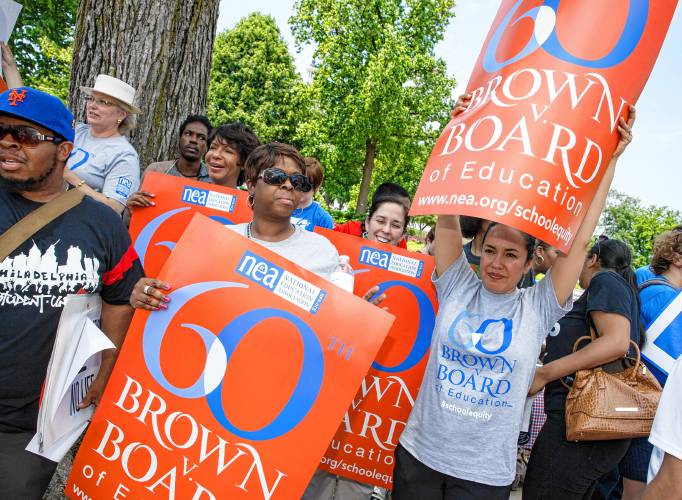Opinion: Brown v. Board of Education and the Claremont Lawsuit
| Published: 05-17-2024 6:00 AM |
Richard W. Osborne lives in Contoocook.
Today, May 17, is the anniversary of a milestone in American jurisprudence. It was on this date, seventy years ago that the United States Supreme Court handed down a decision in the case of Brown v. Board of Education. Chief Justice Earl Warren wrote the unanimous (9 - 0) opinion in which the Court ruled that separating children in public schools on the basis of race was unconstitutional.
In doing so, the Court overturned a shameful “separate but equal” precedent made nearly 60 years before in Plessy v. Ferguson. Deciding how to enforce the Court’s order was the subject of new arguments presented over the next year, and on May 31, 1955, the Court ordered, in another unanimous opinion by Chief Justice Warren that states should begin their desegregation plans “with all deliberate speed.”
The Brown case was met with resistance by segregationists, state governments and by some legal scholars who claimed the Court had overstepped its constitutional grounds. Nevertheless, Brown v. Board of Education gave new life to the civil rights movement. New leaders such as Fannie Lu Hamer and Ella Baker emerged, and within a decade, the Civil Rights Act and the Voting Rights Act were passed by Congress and signed into law by President Johnson. Amid courageous protests, and sometimes violent acts of repression, the rule of law prevailed.
In New Hampshire, there was decades-long debate over what began as several court cases. In 1993, 1997 and once again in 2023, towns, cities and school districts fought for what they believed has been denied them and the children in their communities, that the state of New Hampshire has to provide and pay for an “adequate education,” a constitutional requirement it has failed to meet. In the 1993 and 1997 Claremont decisions, the New Hampshire Supreme Court said that is so. The Court said so a third of a century ago and said so again just four years later.
Now come two more court challenges to the New Hampshire way of meeting its obligation. Judge David Ruoff, a jurist on the New Hampshire Superior Court sitting in Rockingham County, did the courageous thing. He heard the case of ConVal School District versus State of New Hampshire himself instead of referring it to the to the state Supreme Court. He studied the arguments and made his decision in November of last year.
The state provides what’s called a “base adequacy rate” of no less than $4,100 per pupil to public school districts, but Judge Ruoff found that the state falls far short of providing a constitutionally mandated “base adequacy rate.” He set a “bare minimum” of $7,356 per K-12 student that would cover the average cost of teacher salaries in New Hampshire, not including costs of custodians, school nurses, building maintenance and other necessities.
Judge Ruoff called the evidence “compelling.” He said his calculations of what would bring the state into compliance with the constitutional mandate were “conservative.” And he said he was offering “appropriate deference to the Legislature” in setting an acceptable amount that would meet the test of adequacy.
Article continues after...
Yesterday's Most Read Articles
 Twelve acres near Concord Walmart cleared for future retail development
Twelve acres near Concord Walmart cleared for future retail development
 25-year-old Concord man identified as Steeplegate Mall RV fire victim
25-year-old Concord man identified as Steeplegate Mall RV fire victim
 Skeletal remains across from state prison identified as Concord fugitive
Skeletal remains across from state prison identified as Concord fugitive
 ‘New Hampshire is just going to embarrass itself’: Former Child Advocate warns against proposed office cuts
‘New Hampshire is just going to embarrass itself’: Former Child Advocate warns against proposed office cuts
 Memorial Field plans, including parking, drainage, track and turf fields, due in the coming months
Memorial Field plans, including parking, drainage, track and turf fields, due in the coming months
 Bow parents appeal court ruling over free speech in transgender athlete protest
Bow parents appeal court ruling over free speech in transgender athlete protest
In another case, Stephen Rand v. State of NH, Judge Ruoff found the statewide education property tax (“SWEPT” for short) is also unconstitutional because it fails to provide funding with a uniform tax for all residents. The state has taken the required steps to appeal the Con-Val case to the Supreme Court, and the Rand case will be re-argued in September. Meanwhile, the Legislature has before it two bills that would go partway toward meeting the requirement of the New Hampshire Constitution that it provide an adequate education for all public school students and pay for it. These two bills have passed the House and are under consideration in the Senate, having received overwhelming support in public hearings.
New Hampshire is a wealthy state by most any measure. It does not lack the resources to meet the requirements of its constitution in the provision of both fairness and adequacy. Which brings us back to today’s anniversary of one of the great decisions of the U.S. Supreme Court. It was a game-changing ruling. New Hampshire taxpayers and New Hampshire school students should be able to look back with pride at having solved a thirty-odd year’s old denial of justice.









 Opinion: My memories of Vietnam 50 years later
Opinion: My memories of Vietnam 50 years later Opinion: Concord officials: Can we sit and talk?
Opinion: Concord officials: Can we sit and talk? Opinion: Trump versus the U.S. Constitution
Opinion: Trump versus the U.S. Constitution Opinion: Protect our winters!
Opinion: Protect our winters!
